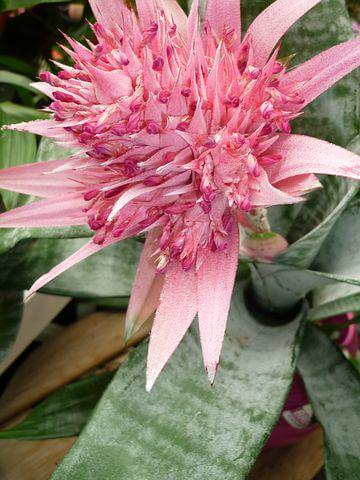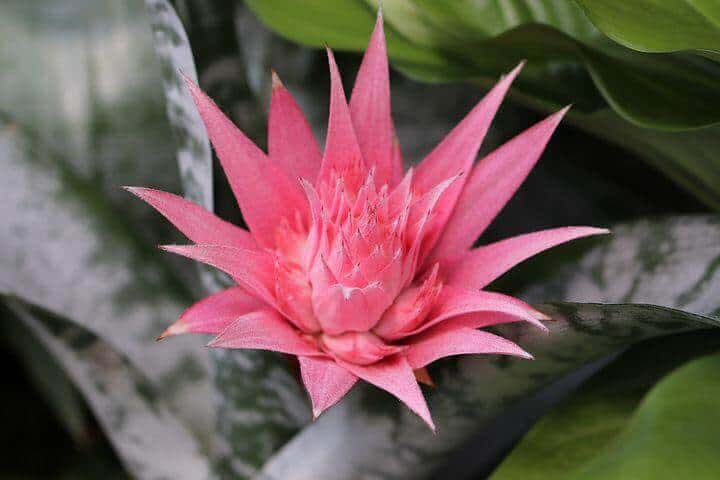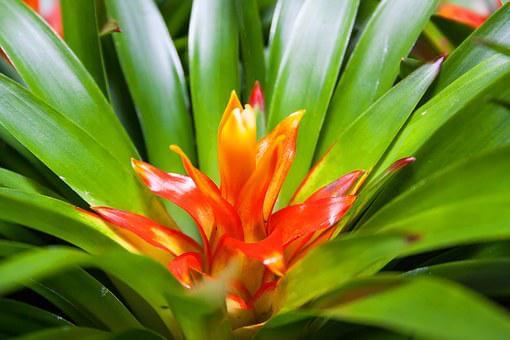Last Updated on January 10, 2023 by a Friendly Gardener
The plant name “Bromeliad” is used to refer to thousands of plant species that are members of the Bromeliaceae plant family. Natives of the tropical and subtropical Americas, many Bromeliad species are perennials. Exotic and unique houseplants, you’ll find lots of plants to choose from.
Due to their exceptional beauty, the Bromeliad is often considered a difficult plant to cultivate indoors. Surprisingly though, this plant readily acclimates to indoor gardening environments. Relatives of the pineapple family, come in lots of colors and varying textures. Blooms are real divas for their showcase beauty, framed by long leaves in a variety of patterns including spots and stripes in differing shades of red, green, orange, yellow, and occasionally purple.

This species can be grown in quality potting soil or cultivated as an epiphyte. Epiphytes generally latch onto tree trunks in native habitats and will gather nourishment through their foliage from plant debris that falls from above.
Bromeliads, when cultivated indoors, are grown in potting soil and will flourish in conditions similar to those of epiphytic orchids. But a Bromeliad is more tolerant of fluctuations in indoor temperatures, even a bit of drought. Slow growers, these plants need one to three years to mature enough to produce flowers.
Bromeliad Plant Care

Bromeliads need certain conditions to bloom and depending on the genus and even varying species within the same genus, these environmental conditions will change with each plant. Flowering will be influenced by humidity, temperature, day length, feeding, and watering. It can be helpful to research the genera and specific plant species to learn what the ideal cultivating conditions are.
Terrestrial or epiphytic bromeliad species when cultivated indoors need to be planted in a potting soil and sand mixture. Moistening the soil bed is fine when watering but you can also fill the center cup formed by the rosette of leaves.
It can be rather difficult to recreate the natural habitat environment needed to bloom, however, a few studies indicate that exposure to ethylene gas can assist in blooming. Place your bromeliad plant in a plastic bag with a ripened apple and seal it closed. Ripe apples emit ethylene as they decompose. The bromeliad’s center cup should not have any water in it.
Soil
Quick-draining potting soil is ideal for bromeliad cultivation indoors. The soil bed should, nonetheless, be able to retain some moisture. To mix an appropriate growing medium, blend 1/3 of sand with 2/3 of peat-based soil. You can also employ a prebagged orchid mixture, a soilless potting mix, or even charcoal. Often epiphytic bromeliads can be grown easily in pots, or you can attach them to logs or wooden boards to grow them like air plants. Attach them securely with glue or ties.
Light

Depending on the bromeliad type plants will require varying levels of light. Some can tolerate direct sunlight exposure, while other cultivars will suffer foliage scorching. As a rule of thumb, bromeliads with flexible soft foliage prefer lower light conditions, and bromeliads that feature a stiffer texture of foliage require bright indirect sunlight.
When a bromeliad becomes yellow, it is most likely getting too much light. Bromeliads with dark green long leaves are receiving too little light. When the environmental conditions for a Bromeliad species are proper, a slight increase in light exposure will assist in getting the plant to flower.
Water and Humidity
Bromeliads tolerate drought. Keeping the center cup filled with water is not required in indoor conditions but if temperatures are high and light conditions are bright, you can do so.
When choosing this option to water your plant, you will need to occasionally flush out the central cup to remove salt build-up. Water sparingly, perhaps once weekly during the growing season, and reduce watering when your plant goes into dormancy in the winter. Bromeliads must never be left standing in water.
When you select to cultivate a bromeliad as an air plant, water more frequently being sure to drench daily and soak weekly.
Ideal humidity levels for indoor cultivation should measure between 40 and 60 percent. In warmer climates, your plant will require more humidity.
Temperature

One great thing about bromeliads is that they tolerate temperature fluctuation. Ideal temperatures should measure in the range of 55° to 80° Fahrenheit. A few species will be cold-hardy and able to survive in temperatures that drop down to 20° F.Generally, however, your environmental temperature should remain above 40° F. Depending on the local climate, some bromeliads will benefit from being placed outside in the summer season.
Feeding
Bromeliads do not require much in the way of feeding. You can fertilize your plant during the growing season once every two to four weeks. A liquid fertilizer that has been diluted to1/4 strength is optimal. Do not feed during blooming or the winter dormancy.
Pruning

Bromeliad flowers can be trimmed away when their color changes because they have begun to die. If you don’t like the appearance, flower stalks can be pruned within the central cup as far as possible. Cutting tools need to be sterile and sharp. Brown foliage can be trimmed away as this will allow the plant to dedicate more energy to the development of pups.
Bromeliad Toxicity
Happily, Bromeliads are not toxic to humans or pets. However, If you suffer from a sensitivity to latex, an allergic reaction is possible upon contact with the bromeliad’s sap.
Pests, Diseases, and Problems
As with many houseplants, the bromeliad may attract mealybugs, aphids, and scale. Bromeliads will generally resist disease. They also do not seem to be subject to severe infestations of houseplant pests. They do exhibit sensitivity to environmental problems including:
- Overwatering. When the soil bed becomes soggy or waterlogged, as opposed to central cup watering, the rot will set in. Dry conditions are preferable.
- Hard water. Water high in mineral content may cause spots in the central cup and at the plant’s base. Demineralized water is preferred if your municipality provides hard water.
- Improper Pot. As a bromeliad does not have an extensive root system or large root ball, they require smaller-sized containers that are well-draining. Water should not be able to collect. An excess will cause rot to develop.
Repotting
Adult bromeliads rarely require a container that measures more than six inches in diameter. Overwatering may take place in larger containers. Very young bromeliads will do fine when cultivated in four-inch containers. Repotting should take place in the spring and only if your plant appears to have outgrown its pot.
Bromeliad Propagation

A bromeliad will have an average life span of three to six months. Bromeliads reproduce by developing “pups” or offsets near the mother plant’s base. Mature Bromeliadscan produces flower spikes that feature small flowers that are not showy and that are surrounded by impressive bracts.
Some flower bracts can last for a few months. When the flower dies, the plant will begin its dying process. Normally the parent plant will produce several pups near its base. Pups can be removed using sterile gardening scissors or shears and repotted in individual pots if they have developed roots and a central cup.
A Final Thought
This exotic beauty is apparently one of the original inhabitants of planet earth, considered to have been present as far back as 65 million years ago. It would seem that the Bromeliads found today aren’t much different from those of antiquity. A Bromeliad is a lovely, colorful addition to indoor gardens.

